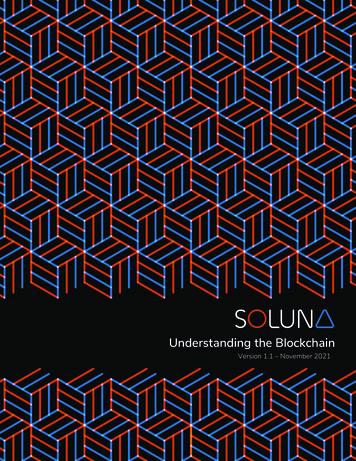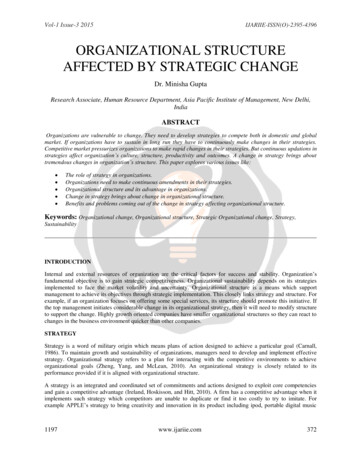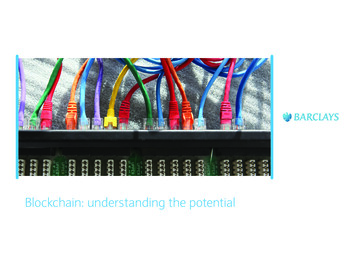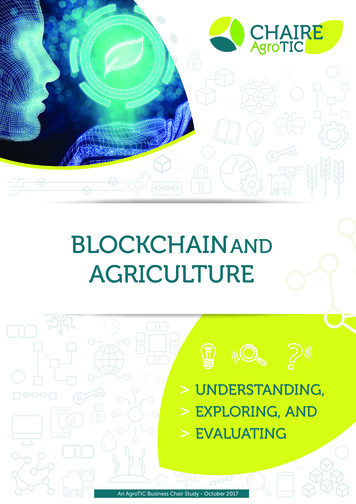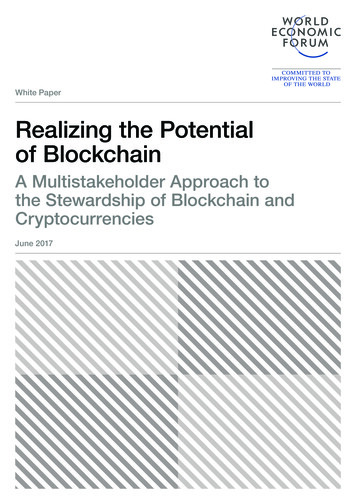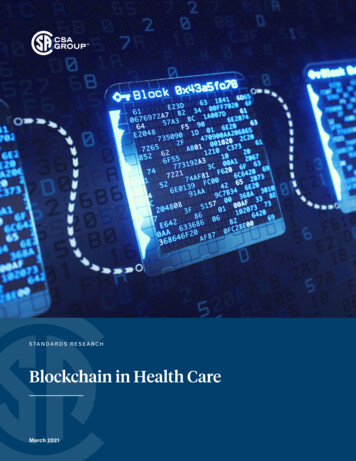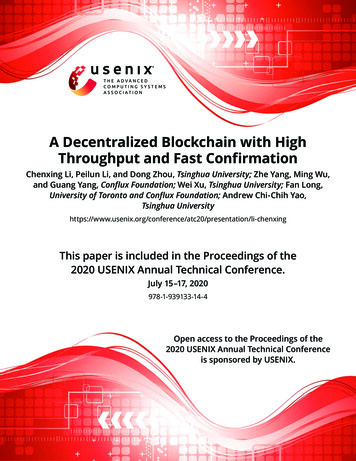
Transcription
A Decentralized Blockchain with HighThroughput and Fast ConfirmationChenxing Li, Peilun Li, and Dong Zhou, Tsinghua University; Zhe Yang, Ming Wu,and Guang Yang, Conflux Foundation; Wei Xu, Tsinghua University; Fan Long,University of Toronto and Conflux Foundation; Andrew Chi-Chih Yao,Tsinghua presentation/li-chenxingThis paper is included in the Proceedings of the2020 USENIX Annual Technical Conference.July 15–17, 2020978-1-939133-14-4Open access to the Proceedings of the2020 USENIX Annual Technical Conferenceis sponsored by USENIX.
A Decentralized Blockchain with High Throughput and Fast ConfirmationChenxing Li , Peilun Li , Dong Zhou, Zhe Yang† , Ming Wu† ,Guang Yang† , Wei Xu, Fan Long‡† , Andrew Chi-Chih YaoTsinghua University † Conflux Foundation ‡ University of TorontoAbstractThis paper presents Conflux, a scalable and decentralizedblockchain system with high throughput and fast confirmation. Conflux operates with a novel consensus protocol which optimistically processes concurrent blockswithout discarding any as forks and adaptively assignsweights to blocks based on their topologies in the Conflux ledger structure (called Tree-Graph). The adaptiveweight mechanism enables Conflux to detect and thwartliveness attack by automatically switching between anoptimistic strategy for fast confirmation in normal scenarios and a conservative strategy to ensure consensusprogress during liveness attacks.We evaluated Conflux on Amazon EC2 clusters withup to 12k full nodes. The consensus protocol of Confluxachieves a block throughput of 9.6Mbps with 20Mbpsnetwork bandwidth limit per node. On a combined workload of payment transactions and Ethereum history transactions, the end-to-end system of Conflux achieves thethroughput of up to 3480 transactions per second whileconfirming transactions under one minute.1IntroductionFollowing the success of cryptocurrencies [2, 23],blockchain has evolved into a technology powering secure, decentralized, and consistent transaction ledgersat Internet-scale. Newer blockchain platforms such asEthereum [2, 35] support customized transaction rules assmart contracts, which greatly extend the capability ofblockchain ledgers beyond value transfers.Blockchain platforms like Bitcoin [23] use Nakamotoconsensus. It organizes transactions into an ordered listof blocks, each of which contains multiple transactionsand a link to its predecessor. Participants (miners) solvesproof-of-work (PoW) puzzles to compete for the right ofgenerating the next block. To prevent an attacker fromreverting previous transactions, honest participants agree Thefirst two authors contributed equally.USENIX Associationon the longest chain of blocks as the correct history. Eachnew block is appended at the end of the longest chain tomake the chain longer and therefore harder to revert.However, the performance remains one of the mostcritical issues of blockchains. Nakamoto consensus isbottlenecked by its slow block generation rate. For example, Bitcoin generates one 1MB block every 10 minutesand can therefore only process 7 transactions per second.Users have to wait for typically one hour (i.e., six blocks)to obtain high confidence on the finality of a transaction.An ideal blockchain has the following four desirableproperties, security, decentralization, high throughput,and fast confirmation. The key challenge of buildingsuch a blockchain system is the threat of security attacks.To obtain high performance, the system typically has tooperate with a fast block generation rate. Because blockpropagation takes time, the system may therefore generate many concurrent blocks (i.e., forks). In Nakamotoconsensus, concurrent blocks waste PoW computation because they do not contribute to the finality of the longestchain. They make the system vulnerable to double spending attacks that attempt to revert history transactions.Moreover, a high block generation rate can make several recently proposed protocols vulnerable to livenessattacks [17, 31, 32]. An attacker can simultaneously generate blocks at two competing branches and strategicallywithhold/release these blocks to maintain the balance ofthe two branches. The attacker with little PoW computation power can stall the consensus progress [36].Conflux: We present Conflux, the first blockchain systemthat achieves all of the four desirable properties. Confluxcan process thousands of transactions per second whileconfirming each transaction with within one minute onaverage. With its novel consensus protocol, the consensuslayer of Conflux is no longer the performance bottleneck,i.e., the throughput saturates its underlying gossip network bandwidth and the confirmation speed is within thesame order of magnitude as the gossip network propa-2020 USENIX Annual Technical Conference515
gation delay. Conflux is provably secure (see our formalproof in [19]). It is also as decentralized and permissionless as Bitcoin — participants can join and leave theconsensus process at any time and there is no privilegedcommittee or super-node dictating the process. Confluxalso implements a modified version of Ethereum Virtual Machine (EVM) [35] and most smart contracts inEthereum can be directly ported to Conflux.To address the security attack challenge, Conflux organizes blocks into a novel Tree-Graph structure, which isa tree embedded inside a direct acyclic graph (DAG). InTree-Graph, concurrent blocks are not considered harmful and they contribute to the Conflux ledger as well.Their PoW solutions will improve the finality of all oftheir ancestors and their transactions will be optimistically included into the ledger total order. This securesConflux against double spending attacks and improvesthe Conflux throughput. To address liveness attacks, theconsensus protocol of Conflux inherently encodes twodifferent block generation strategies: an optimistic strategy that allows fast confirmation and a conservative strategy that ensures the consensus progress. Conflux uses itsnovel adaptive weight mechanism to combine these twostrategies into a unified consensus protocol.Adaptive Weight: Conflux assigns a weight to eachblock, which indicates the amount of finality that theblock contributes to its ancestors. For each new block,Conflux analyzes its topology in the Tree-Graph, decideswhether a liveness attack is potentially going on (e.g.,whether there are old ancestor blocks that are not finalized yet), and then adaptively assigns weights to blocksin the Tree-Graph to switch between the two strategies.In normal scenarios, the mechanism assigns weights inone way that enables the optimistic strategy to confirmtransactions fast. When a liveness attack happens, themechanism assigns weights in another way that enablesthe conservative strategy to thwart the attack.Deferred Execution: The execution order of recentlypackaged transactions may oscillate temporarily in a system with fast block generation. A naive implementationof the transaction execution engine would have to rollback executions many times and waste computation resources. Conflux addresses this challenge with its deferred execution mechanism. Instead of executing transactions in every received block immediately, Confluxwaits for several blocks so that the order is relativelystabilized. Our observation is that users need to wait forthe stabilization of the total order anyway to confirm atransaction with high confidence. Therefore the deferredexecution does not harm the user experience at all.5162020 USENIX Annual Technical ConferenceLink-Cut Tree: An efficient consensus implementationis important to the performance of Conflux. To maintainthe Conflux Tree-Graph, a naive implementation has thetime cost of O(n) for processing a new block on average,where n is the number of existing blocks. To address thischallenge, Conflux uses link-cut tree to maintain weightvalues in Tree-Graph efficiently. It reduces the processingtime from O(n) to O(log n) per block.Experimental Results: We implemented Conflux andevaluated it with Amazon EC2 machines under the sameexperimental setup as previous work like Algorand andOHIE [11, 36]. Our experimental results show that withthe bandwidth limit of 20Mbps and the simulated realworld network latency setting, Conflux achieves a transaction throughput of 9.6Mbps and a confirmation latencyof 47.75-51.54 seconds when running 3000-12000 nodes.For a combined workload of payment transactions andEthereum history transactions, Conflux achieves up to3480 transactions per second and confirms transactionswithin one minute with high confidence. Comparing toAlgorand [11], Conflux has more than 4x higher throughput and comparable confirmation speed. Comparing toOHIE [36], Conflux has the same throughput and oneorder of magnitude faster confirmation speed.Contribution: This paper makes the following contributions: 1) we design and implement Conflux, a decentralized and smart-contract-enabled blockchain system withhigh throughput and fast confirmation; 2) we present anovel consensus protocol with the adaptive weight mechanism; 3) we present a set of novel and critical optimizations, including deferred execution and link-cut tree.2Related WorkNakamoto Consensus in Bitcoin: Transactions arepacked into blocks in Bitcoin. Each block has one predecessor block and all blocks form a tree structure withthe genesis block as the root. Participants agree on thelongest chain as the valid transaction history. Nakamotoconsensus has to use a relatively slow block generation rate to avoid the generation of concurrent blocks,i.e., forks. This is essential for the safety against double spending attacks as shown in Figure 1a. More forkswould mean relatively less blocks in the longest chain.In Figure 1a, due to forks, only 20% of blocks are on thelongest chain so that an attacker with more than 20% ofthe network computation power can revert the longestchain to launch double spending attacks.GHOST: GHOST is a previous proposal to replace thelongest chain rule to improve the consensus safety undera fast block generation rate [32]. It is partially implemented in Ethereum [2]. Figure 1b presents an exam-USENIX Association
ForksThe original longestchain (20% of blocks)Forks G (a) An attacker with more than 20% of the network computation power can revert the longest chain.XXXXXXYYYYNew BlockGenesisY(b) GHOST algorithm iteratively advances to the largestsubtree to select the agreed chain.Malicious BlocksPublic BlocksIn-Transit BlocksNew BlocksX’ X’X XX New Blockfrom X groupY YY New Blockfrom Y groupY’ Y’Expected · d blocks intotal. These blocks are onlyvisible to their own group.G latexit sha1 base64 "YPQ6RFPy//dSHO7eZ2QRP1Ii8wM " AAAB Wg9ywjNARGbCepZKkzIST LLAcm6WJRkgsMCs9awDHXjIIYW0Ko5vZWTIdEEwq2q7ItwV/ 8ipp12v Ra1 f1lt3BR1lNAJOkXnyEdXqIHuUBO1EEU5ekav6M15cl6cd djEV1ziplj9AfO5w8GRpKs /latexit (c) The attacker can strategically withhold or release his/herblocks to maintain the balance of two subtrees.X’ X’Weighted Block (only 1/h blocks)X XX Y YY Y’ Y’New Blockfrom X groupZero Weight BlockGNew Blockfrom Y group(d) If h is large enough, two groups will converge eventually.Figure 1: Double Spending Attack, GHOST, Liveness Attack,and Structured GHOSTple to illustrate the GHOST algorithm. GHOST startsfrom the genesis block and iteratively advances to thechild block with the largest subtree to select the agreedchain [32]. In Figure 1b, the new block appends to theend of the agreed chain, which is in the subtree of X(containing 6 blocks) not in the subtree Y (containing 5blocks). The difference between GHOST and the longestchain rule is that all blocks generated by honest participants will contribute to the finality of the agreed chain.Suppose G is an old enough block that is on the agreedchains of all honest participants. Future blocks generatedby honest participants will all contribute the finality of Gregardless of whether they are concurrent or not, becauseall of these blocks will be under the subtree of G. Unlikethe longest chain rule, an attacker would need more thanhalf of computation power to revert G from the agreedchain even with the presence of concurrent blocks [32].USENIX AssociationLiveness Attack on GHOST: Unfortunately, GHOST isvulnerable to liveness attacks if the block generation rateis very fast. Figure 1c presents one example of such attacks. The example has the following settings: 1) the totalblock generation rate of honest participants is λ; 2) honest participants are devided into two groups with equalcomputation power (group X and group Y in Figure 1c);3) blocks will transmit instantly inside each group, butthe propagation between these two groups has a delayof d. In Figure 1c, each of the two groups extends itsown subtree following the GHOST rule. Note that recent generated blocks within the time period of d arein-transit blocks (gray blocks in Figure 1c), which areonly visible by the group who generates them. Thereforeeach group will believe its own subtree is larger until onegroup generates sufficiently more blocks than the otherto overcome the margin caused by the in-transit blocks.In normal scenarios, one of the two groups will getlucky to enable the blockchain to converge. However,an attacker can mine under two subtrees simultaneouslyto delay the convergence. The attacker can strategicallywithhold or release the mined blocks to maintain thebalance of the two subtrees as shown in Figure 1c.Theoretically, if honest participants evenly split due tonetwork delay and the margin caused by in-transit blocksis significant, i.e., λd 1, a small portion of computationpower is enough to launch attacks. Previous work [36] includes a simulation shows only 10% will do. In practice,even if honest participants do not have an even partition, the more computation power the attacker controls,the more likely the attacker will succeed. Consider thepresence of mining pools, it is not rare to see one minercontrolling more than 20% of computation power. Sucha miner will be able to launch successful balance attackswithout even partition.DAG-based Structures: To improve the throughput andthe confirmation speed, researchers have explored several alternative structures to organize blocks. Inclusiveblockchain [17] extends the Nakamoto consensus andGHOST to DAG and specifies a framework to includeoff-chain transactions. In PHANTOM [31], participatingnodes first find an approximate k-cluster solution for itslocal block DAG to prune potentially malicious blocks.They then obtain a total order via a topological sort of theremaining blocks. Unfortunately, when the block generation rate is high, inclusive blockchain and PHANTOMare all vulnerable to liveness attacks similar to Figure 1c.Therefore, unlike Conflux they cannot achieve both thesecurity and the high performance.Some protocols attempt to obtain partial orders insteadof total orders for payment transactions. SPECTRE [30]2020 USENIX Annual Technical Conference517
produces a non-transitive partial order for all pairs ofblocks in the DAG. Avalanche [4] connects raw transactions into a DAG and uses an iterative random samplingalgorithm to determine the acceptance of each transaction. Unlike Conflux, it is very difficult to support smartcontracts on these protocols without total orders.Hierarchical and Parallel Chains: Besides DAG, alternative ways to organize blocks include hierarchical chains and parallel chains. For example, in BitcoinNG [9], a macro block is generated every 10 minutes.The miner of such a block becomes the leader to generate micro blocks that contain actual transactions untilthe next macro block. Similarly, FruitChain [27] packstransactions first into fruits (i.e., micro blocks) and thenpacks fruits into blocks. OHIE [36] runs multiple parallelchains with the standard Nakamoto consensus and thendeterministically sorts blocks to obtain a total order.The shared property of these protocols is that only asmall portion of blocks (e.g., macro blocks in BitcoinNGand FruitChain) influence the total order of the transaction ledger. It mitigates the liveness attack issue in Figure 1c because it reduces the chance of in-transit blocksinfluencing the total order. But these protocols have slowconfirmation speed because they need to wait for moreblocks to confirm transactions than other protocols. Forexample, BitcionNG has the same slow confirmationspeed as Bitcoin [9]; OHIE confirms transactions in about10 minutes on average only under an extremely fast blockgeneration rate of 64 blocks per second [36]. In contrast,Conflux has a much faster confirmation speed in normalcircumstances with no ongoing liveness attack.Prism operates with one proposer chain and many parallel vote chains, each of which casts vote to decide thetotal order of blocks in the proposer chain [6]. The theoretical simulation in [6] shows that Prism may achievehigh throughput and fast confirmation speed similar toour Conflux results in Section 6. But the simulation assumes a block propagation delay of one second, whichis too ideal (e.g., the measured block delay is 10-15 seconds in our experiments). It is therefore unclear how fasta blockchain system that implements Prism can confirmtransactions when running under practical P2P networks.Byzantine Fault Tolerance: ByzCoin [14] and Thunderella [28] propose to achieve consensus by combiningthe Nakamoto consensus with Byzantine fault tolerance(BFT) protocols. Algorand [11], HoneyBadger [22], andStellar [21] replace the Nakamoto consensus entirelywith BFT protocols. In practice, all these proposals runBFT protocols within a confined group of nodes, sinceBFT protocols only scale up to dozens of nodes. Theconfined group is often chosen based on their recent5182020 USENIX Annual Technical ConferencePoW computation power [14, 28], their stakes of the system [11], or external hierarchy of trusts [21, 22]. However, these approaches may create undesirable hierarchiesamong participants and compromise the decentralizationof blockchain systems. In contrast, Conflux allows anyparticipant to join and leave the network without permission. In addition, instead of eagerly deciding the total order of blocks as in BFT-based approaches, Conflux allowsmultiple blocks to be generated in parallel and finalizestheir orders later, which leads to its higher throughput.Sharding: Elastico [20], OmniLedger [15], RapidChain [37], and Monoxide [33] split the blockchain stateinto shards. Instead of having every node to verify alltransactions, the systems select a small committee tomaintain each shard to improve scalability. Unlike Conflux, such systems sacrifice security for scalability, i.e.,the committee configuration can only be changed slowly(like days) due to reconfiguration overhead and thereforea small shard may be vulnerable to powerful attackerswho can adaptively corrupt participants. This securityissue is so important that Vault [16] chooses to only usesharding to mitigate storage cost with the trade-off ofincreased network bandwidth cost. Also despite the highcombined throughput of all shards, the throughput ofinter-shard transactions is still limited.3OverviewWe will first present an example to illustrate a strawman algorithm called structured GHOST that can defend against liveness attacks but has a sub-optimal confirmation speed. We will then present an overview of theConflux consensus protocol, which uses the straw-manalgorithm as a building block.Structured GHOST: In our structured GHOST algorithm, only 1/h of blocks are weighted blocks that wouldcount in the chain selection process. These blocks areselected randomly based on their PoW solution qualities (e.g., the number of leading zeros of the PoW hash).During the chain selection, the structured GHOST iteratively advances to the subtree with the largest number ofweighted blocks, instead of considering all blocks.Figure 1d shows an example to illustrate how structured GHOST can defend against the liveness attack wedescribed before. With a sufficiently large h value, theexpected number of in-transit weighted blocks (λd/h)will be very small. As shown in Figure 1d, the generation of a weighted block of one group will very likely tomake the two subtrees to converge, unless another groupgenerates a concurrent weighted block. When λd/h 1,the chance of such concurrent generation is very unlikely.Without the margin caused by the in-transit blocks, theUSENIX Association
Tx0: Mint 10 coins to XTx1: X sends 8 to YTx2: X sends 8 to ZTx3: X deploys FooAGenesisTx0DGTx3CEHLiveness AttackLaunchedNAdaptive WeightTriggered AdaptiveWeight End Tx1BTx2Tx3) YesFJIKIs the pastsub-graph safefrom liveness Noattacks? (a) Tree-Graph Example. Solid blocks have weight one. Double-line blocks have weight600. Dotted-line blocks have weight zero.Figure 2: Examples of Conflux Consensus on Tree-Graphliveness attack is not possible without significant computation power. Although structured GHOST is secureagainst liveness attacks, it sacrifices the confirmationspeed — a user has to wait for the accumulation ofenough weighted blocks to confirm a transaction.Consensus with Two Strategies: The Conflux consensus protocol operates with two strategies, an optimisticstrategy similar to the GHOST algorithm and a conservative strategy similar to the above straw-man algorihtm. Our adaptive weight mechanism enables Confluxto encode these two strategies in a unified framework.In normal scenarios, Conflux would use the optimisticstrategy to achieve high performance. If a liveness attackhappens, the adaptive weight mechanism enables honestparticipants of Conflux to cooperatively switch to theconservative strategy to thwart the attack automatically.Tree-Graph: The Conflux consensus protocol operateson the local Tree-Graph state of each individual node.Figure 2a presents a running example of the local TreeGraph state of a node in Conflux. We will use this example in the remaining of this section to illustrate thehigh-level ideas of the Conflux consensus protocol. Eachvertex in the Tree-Graph in Figure 2a corresponds to ablock. In Figure 2a, Genesis is the predefined genesisblock. Only Genesis, A, B, and G are associated withtransactions. There are two kinds of edges in the TreeGraph, parent edges and reference edges:Parent and Reference Edges: Each block except Genesis has exactly one outgoing parent edge (solid linearrows in Figure 2a). For example, there is a parent edgefrom C to A. Each block can have multiple outgoing reference edges (dashed line arrows in Figure 2a). A referenceedge corresponds to generated-before relationships between blocks. For example, there is an edge from E to D.It indicates that D is generated before E.Pivot Chain: Note that all parent edges in the TreeGraph together form a parental tree in which the genesisblock is the root. In the tree, Conflux selects a chain fromthe genesis block to one of the leaf blocks as the pivotchain. Each block in the Tree-Graph may have a differentUSENIX Associationf(Weight ofthe newblockAssign 1Assign h with1/h chance.Otherwise 0.(b) Adaptive Weightweight determined by our novel adaptive weight mechanism. Conflux iteratively advances to the subtree withthe heaviest total block weight to select the pivot chain.In Figure 2a before the liveness attack, Conflux selectsGenesis, A, C, E, and H as the pivot chain to append thenew block N. Note that Conflux does not selects the chainof Genesis, B, F, J, I, and K, because the subtree of A hasheavier weights than the subtree of B.Generating New Block: Whenever a node generates anew block, it first computes the pivot chain in its localTree-Graph state and sets the last block in the chain asthe parent of the new block. The node then finds all tipblocks in the Tree-Graph that have no incoming edgeand creates reference edges from the new block to eachof those tip blocks. For example, in Figure 2a, whengenerating N, the node chooses H as the parent of N andcreates a reference edge from N to K.Adaptive Weight: Figure 2b illustrates the basic idea ofthe adaptive weight mechanism. The goal is to assign adifferent weight to each generated block so that Confluxcan adaptively switch between the optimistic strategywith a fast confirmation and the conservative strategythat ensures the consensus progress. Conflux determinesthe weight of a new block based on its past sub-graph,i.e., all blocks that are reachable via a traversal from thenew block. As shown in Figure 2b, if the past sub-graphis safe — every old enough ancestor of the new blockin the past sub-graph is secured on the pivot chain withhigh probability, the weight of the new block will be one.If not, the new block will be assigned an adaptive weight— it gets a weight of h with the chance of 1/h (dependingon the PoW quality) or zero otherwise. Note that we seth 600 in Conflux. See Section 4.1.Liveness Attack Resilience: Figure 2a shows how theadaptive weight mechanism stops liveness attacks. Suppose after the generation of N, an attacker launches aliveness attack similar to one described in Figure 1cto balance the subtree of A and B. After a while, allhonest participants start to generate blocks with adaptive weights, because they find that the old ancestors of2020 USENIX Annual Technical Conference519
their new generated blocks (e.g., A or B in Figure 2a) arestill not secured on the pivot chain with high probability. This essentially enables the consensus protocol tooperate in the conservative strategy similar to the structured GHOST algorithm. In Figure 2a, the heavy weightblocks make Conflux to converge to the the subtree ofA. After more blocks being generated under A, the pastsub-graph of new generated blocks will become safe. Participants therefore assign weight one to the new blocks,automatically swtiching back to the optimistic strategy.Epoch and Block Order: Parent edges, reference edges,and the pivot chain together enable Conflux to split allblocks in a Tree-Graph into epochs. Every block on thepivot chain corresponds to one epoch. Each epoch contains all blocks 1) that are reachable from the corresponding block in the pivot chain via the combination of parentand reference edges (including the pivot chain block itself) and 2) that are not included in previous epochs. Forexample, in Figure 2a, J belongs to the epoch of H because J is reachable from H but not reachable from theprevious pivot chain blocks.Conflux then derives a total order of all blocks in theTree-Graph with the following rules. Conflux first sortsblocks based on their epochs. For blocks within the sameepoch, Conflux sorts them based on their topologicalorder. Conflux break ties determinisitcally (e.g., withthe PoW quality or the block hash). For example, in Figure 2a, Conflux will obtain the following block total orderfor all blocks before the liveness attack: Genesis, A, B,C, D, F, E, G, J, I, H, K, and N.Transaction Order: Conflux first sorts transactionsbased on the total orders of their enclosing blocks. Iftwo transactions belong to the same block, Conflux sortsthe two transactions based on the appearance order inthe block. Conflux checks the conflicts of the transactions at the same time when deriving the order. If twotransactions are conflicting with each other, Conflux willdiscard the second one. If one transaction appears in multiple blocks, Conflux will only keep the first appearanceand discard all redundant ones. In Figure 2a, the transaction total order is Tx0, Tx1, Tx2, Tx3, and Tx3. Confluxdiscards Tx2 because it conflicts with Tx1.4Consensus on Tree-GraphThe local state of a node in Conflux is S hB, gi, where Bis the set of blocks and g B is the genesis block. Thereare several fields associated with a block b B. b.parentdenotes the parent block of b. b.pred blocks denotes theset of predecessor blocks linked by the reference andparent edges from b. b.pow quality is the quality of thePoW solution — for b to be valid, b.pow quality must no5202020 USENIX Annual Technical ConferenceChild(B, b) {b0 b0 B, b0 .parent b}SubT(B, b) ( i Child(B,b) SubT(B, i)) {b}SubTW(B, b) i SubT(B,b) i.weightPast(b) ( i b.pred blocks Past(i)) b.pred blocksPastW(b) i Past(b) i.weightFigure 3: The definitions of utility functions.2Input :A set of blocks B and a starting block b.Output :The pivot block for the subtree of b.if Child(B, b) 0/ thenreturn b3else15w max{SubTW(B, i) i Child(B, b)}a arg min {i.hash SubTW(B, i) w}6return Pivot(B, a)4i Child(B,b)Figure 4: The definition of Pivot(B, b).less than the PoW difficulty D. b.weight is the adaptiveweight of b. We use b.hash to denote the hash of b – allnodes in Conflux share a predefined deterministic hashfunction that maps each block to a unique id.Figure 3 defines several utility functions and notations.Child() returns the set of child blocks of a given block.SubT() returns the set of blocks in the subtree of a givenblock in the parental tree. SubTW() returns the sum ofthe weights in the subtree. Past() returns the set of blocksthat are generated before a given block. PastW() returnsthe sum of the weights of the past block set of a block.Note that Past(b) and PastW(b) are determined at thegeneration time of b and remain constant afterwards. Inthis section, we use lists to denote chains and serializedorders. “ ” denotes the concatenation of two lists.4.1Pivot Chain and Adaptive WeightPivot Chain: Figure 4 presents the pivot chain selectionalgorithm in Conflux. Given a set of blocks B and thestarting genesis block g, Pivot(B, g) returns the leaf blockof the selected pivot chain. The algorithm recursivelyadvances to the child block whose corresponding subtreehas th
confirming transactions under one minute. 1Introduction Following the success of cryptocurrencies [2,23], blockchain has evolved into a technology powering se-cure, decentralized, and consistent transaction ledgers at Internet-scale. Newer blockchain platforms such a
